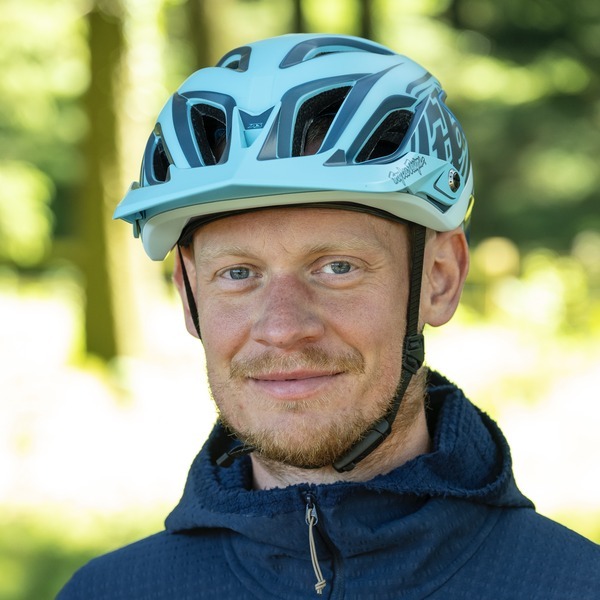It's not often that a bike comes along and totally breaks the mould for what a bike should look like. The big names continually evolve their models and occasionally someone like Mojo will come from nowhere with something completely different — the Geomotron is a massively stretched Nicolai and groundbreaking in its own way.
- Bike of the Year 2017: Radon Swoop 170 8.0 wins Enduro Bike of the Year
- Whyte steps into new territory with 29er enduro rig
Small to mid-size manufacturers' bikes often have similarities to bigger brand bikes, simply because there are only so many economical ways to place pivots in the right places, and few people are keen to risk massive investment in moulds to create something truly unique.
But what if you're not trying to hit a price point? What if you're not trying (at the start, at least) to go mass-market? You then have the freedom to truly transform things, to try something a little different, to work with new linkage systems and frame shapes.

This is what ARBR has done. This is the Saker.
The ARBR Saker is not a completely new bike, having been in development for a number of years, and the pre-production bike was all over the internet in late 2016, but we've got a first look of the first full-production bike — which is ready to order now.
Design
ARBR wanted to build the ultimate 160mm travel enduro bike without any compromises. A bike that pushed the boundaries of both performance and construction methods, and used the team's considerable experience in Formula 1 and World Super Bike construction.
The team had a number of ride quality goals when designing the Saker.
First, a rearward axle path was believed necessary to give a smooth ride over rocks and roots, in order to help maintain speed. As the wheel hits rough ground it moves back and up, reducing harshness over terrain. This is achieved by using a high pivot placement.
The flip-side to this high placement is that chain growth is greater with a traditional drivetrain set-up. As such, the chain is routed over an idler wheel, removing this influence.

ARBR wanted a 100 percent anti-squat characteristic in the lower gears in order to make climbing as efficient as possible. It also wanted a progressive shock rate, which gives suppleness at the start of the stroke and progression towards the end for good grip levels and control through bigger impacts.
By building its rocker mechanism, ARBR says it's achieved this without relying on an over-damped shock, or one stuffed with volume spacers, which it believes compromises the shock's ability to deal with heat build up.

Build
The team at ARBR has built the frame using techniques found in motorsport and aerospace. These are common claims seen across the industry, however few manufacturers actually use the Autoclave Process found here, as for mass manufacturing, it's too time consuming and expensive.
The handmade process is relatively complex, but ARBR has spent time making sure every sheet of the pre-impregnated carbon is used in exactly the right place and for the right reasons.
Frame stiffness has been controlled, though. Too stiff and a bike feels harsh and can be tough to keep a handle on off-camber terrain. ARBR says it's made sure some frame flex exists to provide grip and control in these situations.

The front of the bike is a monocoque, while the rear is made from two individual chainstays that are bonded together at the bridge between the wheel and front triangle. ARBR's own site has a fairly comprehensive look at how the frame is built.
The alloy linkage system works on a droplink from the bottom of the swing arm, which then turns a dog-link below the shock. This then compresses the shock. By having the linkage low in the frame, weight distribution is improved, as is the case with the shock's location in the mainframe. The main bearing looks to have a large diameter, which should provide reliability.

Geometry
It's fair to say that the geometry of the ARMB isn't super progressive, but stacks up well against its competition. In some ways we expected more radical numbers when you look at how far removed the ARBR is from your 'average' enduro bike, but that's not to suggest that the ARBR will have a dated ride.

There are two sizes available, with the larger having a reach of 465mm, a stack of 606mm and seat tube of 459mm. The wheelbase is 1,220mm.
The head angle is 65.1 degrees while the seat angle is 74.5. There's a 10mm bottom bracket drop and 435mm rear centre, which looks on paper well balanced to the front.
Getting hold of one

ARBR will be building the Saker in small batches, with a local company fabricating the frames in the UK.
There's a lead time between buying and receiving the frames, as they're built and hand-painted to order — in fact, buyers can specify the colours used on the frame (so long as they're not too gopping!).
ARBR is working with a number of component suppliers, so there are options from frame-only to full build, depending on what you want. Frames start at £4,390 and then the sky's the limit, really.







